RG Cable Explained: RG58, RG6, RG142, RG213, RG316 and More
Aug 21,2025
Introduction
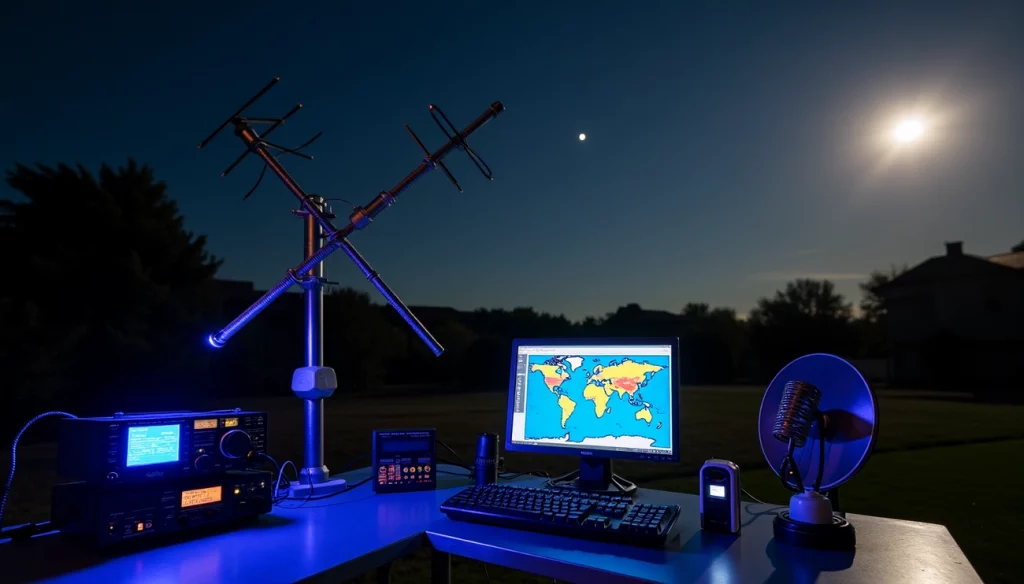
RG cables, short for Radio Guide, are essential for clear signals and reliable data transmission, used in applications from home TV setups to aerospace.
If you’ve ever set up a TV, tuned a ham radio, or wired a satellite dish, chances are you’ve used an RG cable without giving it much thought. On the surface, these cables look like ordinary wires. In reality, they’re the backbone that keeps video signals sharp, radio calls clear, and data flowing reliably across systems.
The term RG, short for Radio Guide, dates back to U.S. military standards in the 1940s. What started as a simple classification system has since become the everyday language of coaxial cabling. Today, when someone mentions an RG58 coaxial cable or an RG6 coaxial cable, they’re talking about specific designs with defined sizes, shielding, and electrical properties.
Not all RG cables are interchangeable, though. A 50-ohm line like RG58 is ideal for radios, test benches, and networking gear, while a 75-ohm workhorse like RG6 rules the world of TV, broadband, and satellite feeds. Need something tougher? RG213 coaxial cable is built for outdoor power and military-grade durability. On the other end of the spectrum, compact options like RG316 or RG178 squeeze into GPS units, drones, and IoT modules. And in aerospace, engineers rely on precision performers such as RG142 or RG405 to handle high frequencies with minimal loss.
So, when the question comes up—“Which RG cable should I choose?”—the honest answer is: it depends on your application. In this guide, we’ll unpack the most common RG cable types, compare their specifications, and help you match the right coaxial cable to the right job.
What Does RG Mean in Cable?
The letters RG stand for Radio Guide. It wasn’t a catchy brand slogan but a straightforward label created by the U.S. military during the 1940s. At the time, engineers needed a standardized way to catalog different coaxial cable designs, so each one was assigned an “RG number.” That system stuck, and decades later, the same shorthand is still used in both professional and consumer markets.
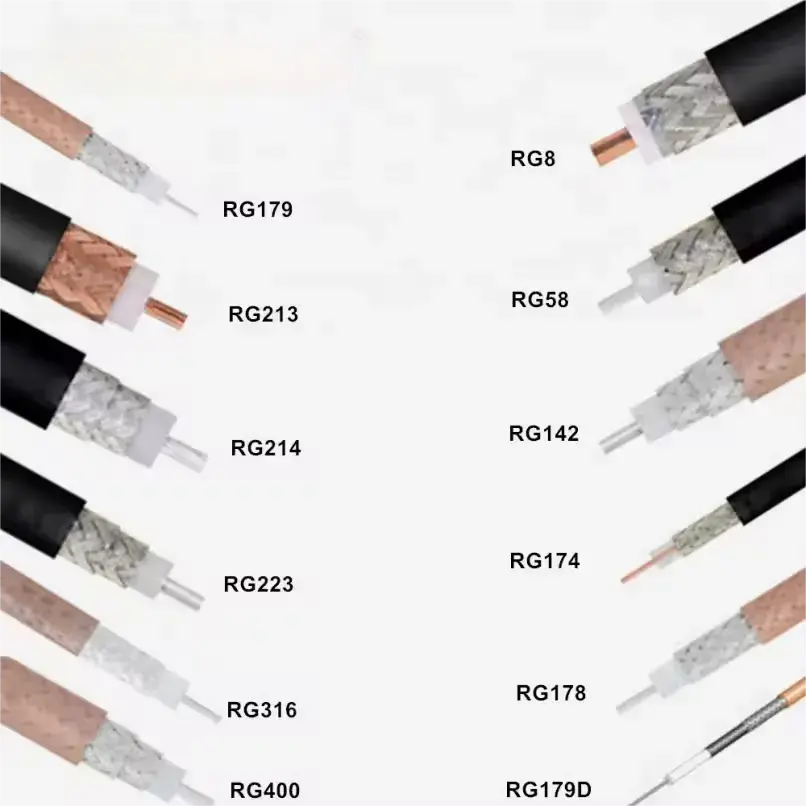
Different RG cables serve different applications: RG58 for radios, RG6 for TV, RG213 for outdoor, RG316/RG178 for IoT and aerospace.
But here’s the catch: the “RG” prefix itself doesn’t tell you much beyond the fact that it’s a coaxial cable. The real differences come from the number that follows—that’s where impedance, size, and shielding style are defined. For example:
- RG58 coaxial cable – a 50Ω line, flexible and easy to work with, popular in radios, CCTV, and networking gear.
- RG6 coaxial cable – a 75Ω staple for TV, satellite, and broadband connections.
- RG213 coaxial cable – thicker, more rugged, and a favorite for outdoor power applications.
- RG142 and RG405 – high-frequency performers for aerospace and defense systems.
- RG178 and RG316 coaxial cable – slim, lightweight, and perfect for GPS units, drones, and IoT devices.
Think of the “RG” label as a family name, while the number is the individual identity. You wouldn’t use RG174 coaxial cable to replace RG6 in a home theater, just like you wouldn’t expect RG213 to fit inside a compact GPS module. Once you know the number, you know the cable’s physical size, electrical behavior, and—most importantly—where it actually belongs.
Common RG Cable Types
The RG cable family is huge, but you don’t need to memorize every model number to make sense of it. A good way to cut through the confusion is to group them into four broad categories: TV & Video Cables, General-Purpose RF Cables, High-Performance RF Cables, and Miniature RF Cables.
1. TV & Video Cables: RG6, RG59, and RG179
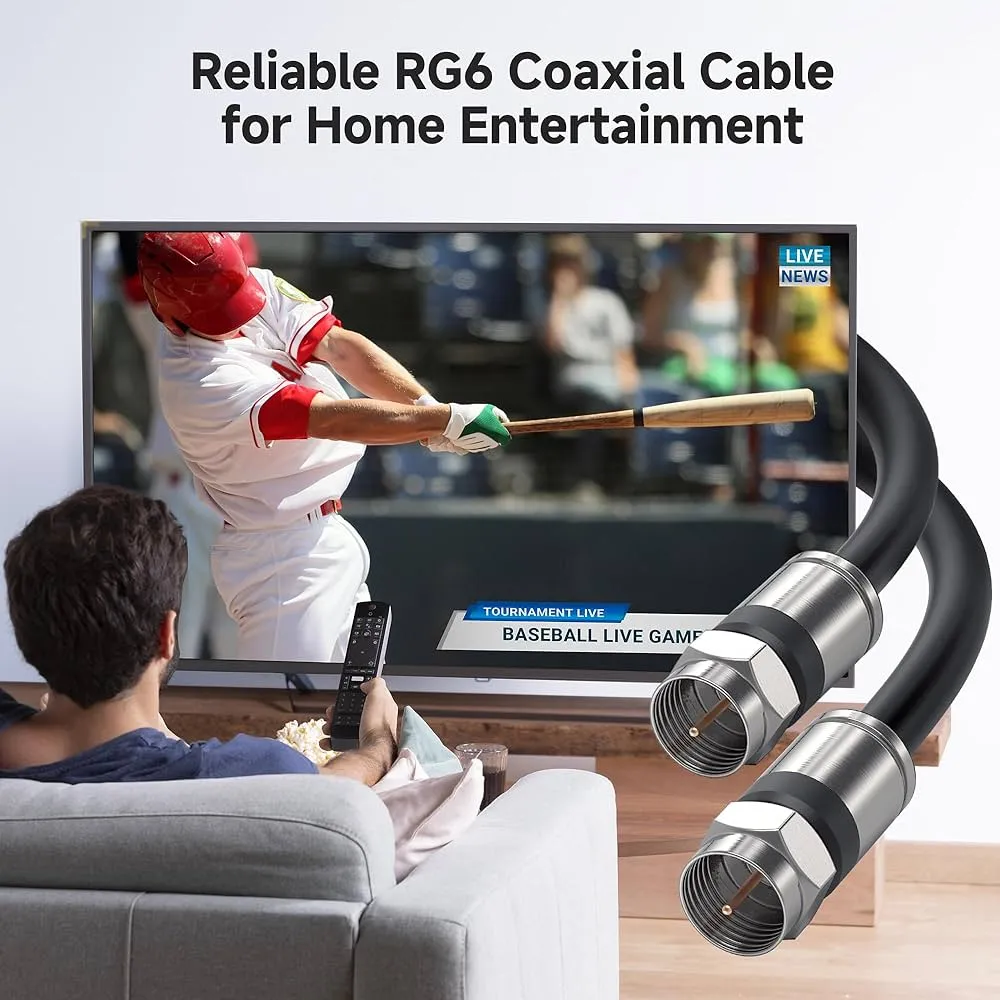
RG6 coaxial cables are widely used in TV, satellite, and cable systems, providing strong shielding and low signal loss for clear HDTV reception.
- RG6 coaxial cable – The standard for television, satellite, and broadband. Thick insulation, strong shielding, low attenuation.
- RG59 – Older, slimmer, and mostly found in analog CCTV or short runs.
- RG179 – A compact 75Ω line with fluoropolymer jacket, reliable in broadcast and instrumentation.
Bottom line: RG6 for modern TV/broadband, RG59 for short analog runs, RG179 for pro broadcast gear.
2. General-Purpose RF Cables: RG58, RG213, and RG223
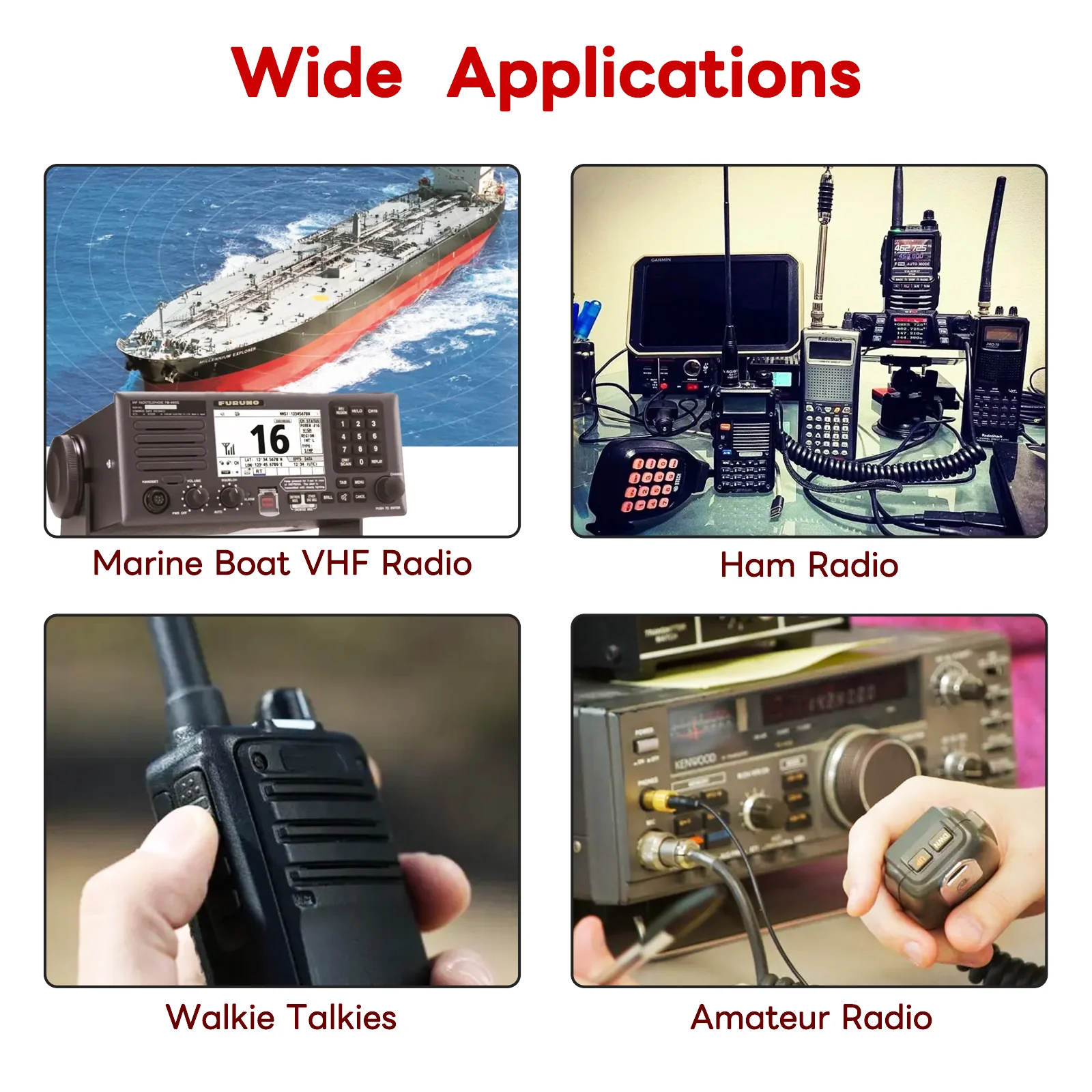
RG58 is flexible but lossy, RG213 is outdoor-rugged, and RG223 provides double shielding for EMI-sensitive environments
- RG58 coaxial cable – Flexible, cheap, common in radios, CCTV, labs, but high loss on long runs.
- RG213 coaxial cable – Thick, durable, low loss, perfect for military, ham radio, outdoor installations.
- RG223 – Double-shielded, EMI-resistant, used in aerospace, defense, and lab testing.
Quick recap: RG58 for short runs, RG213 for outdoor power, RG223 for EMI-sensitive setups.
3. High-Performance RF Cables: RG142, RG316, RG402, RG405, and RG141

RG142 handles power, RG316 offers flexibility, RG402/405 are semi-rigid with low loss for aerospace.
- RG142 – Silver-plated, low loss, built for radar and aerospace.
- RG316 coaxial cable – Slim and flexible, common in GPS and Wi-Fi adapters.
- RG402 – Semi-rigid, stable, used in microwave and aerospace assemblies.
- RG405 – Semi-rigid, ultra-low loss, found in radar and precision RF labs.
- RG141 – Similar to RG142, defense-grade reliability.
Takeaway: RG142 for power, RG316 for flexibility, RG402/RG405 for semi-rigid stability, RG141 for defense.
4. Miniature RF Cables: RF0.81, RF1.13, RF1.37, RG174, RG178, and RG047
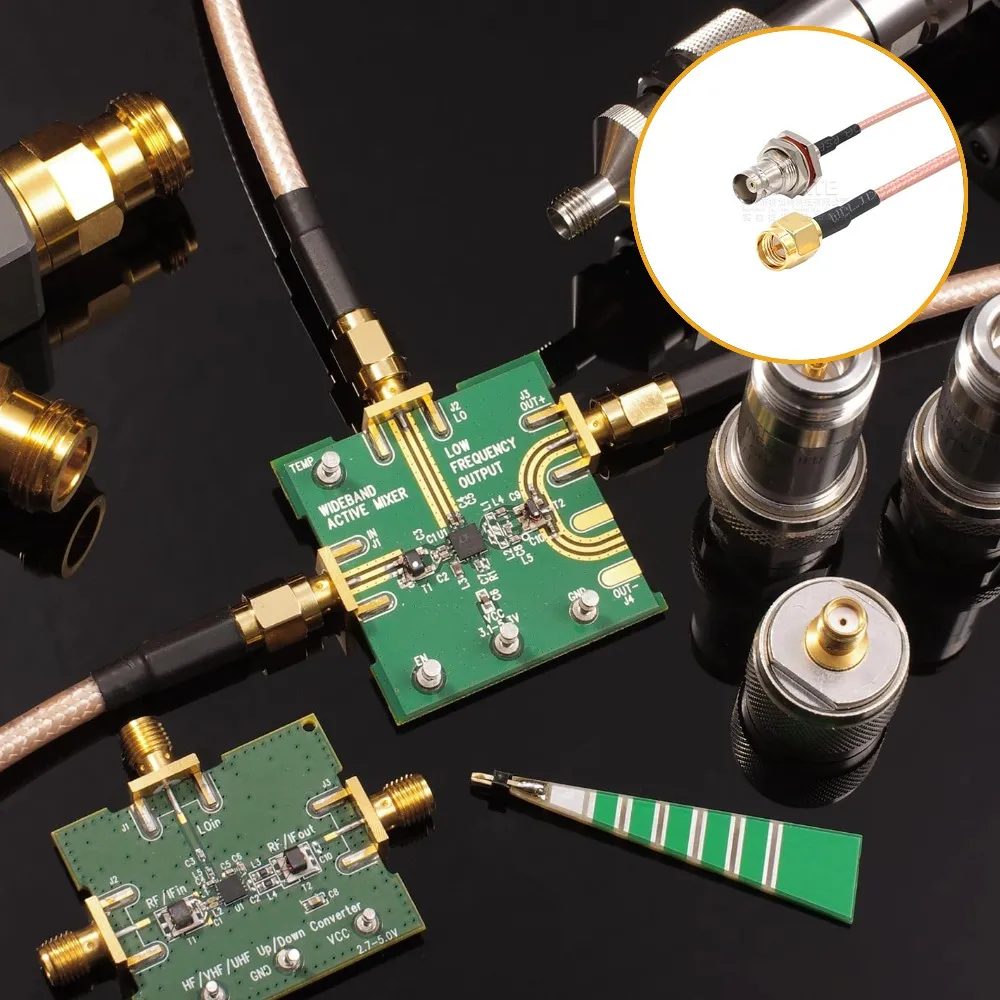
Small-diameter RG cables provide compact routing for embedded systems but trade off power handling.
- RF0.81/1.13/1.37 – Ultra-thin for IoT boards, GPS modules (often with U.FL connectors).
- RG174 coaxial cable – Slim and flexible, but lossy, used in antennas and patch leads.
- RG178 – High-temp resistance, compact, reliable in GPS and aerospace modules.
- RG047 – Semi-flex, niche choice in precision RF assemblies.
In short: Miniature cables trade power handling for size and flexibility, vital in IoT and embedded wireless systems.
RG Cable Comparisons
With so many RG cable types out there, it’s easy to wonder how they stack up against each other. The truth is, most comparisons come down to four things: impedance, cable size, signal loss, and intended use. Below are the head-to-head matchups people search for the most.
RG6 vs RG59
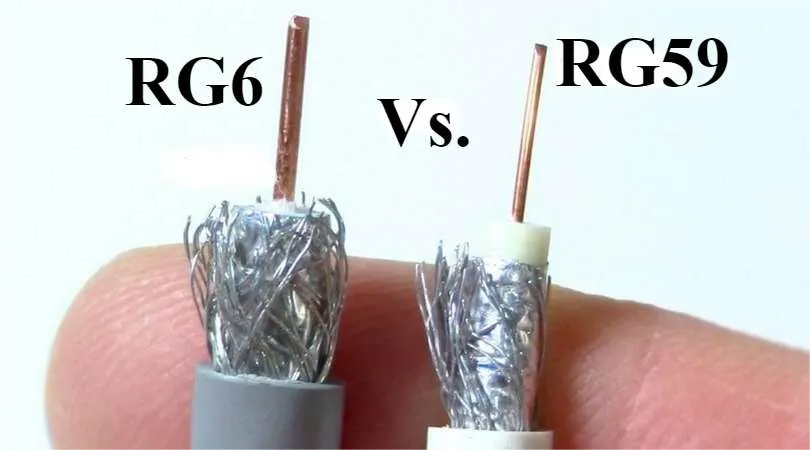
RG6 has stronger shielding and lower loss, ideal for HDTV and broadband, while RG59 is used in older CCTV
Both are 75Ω video coaxial cables, but they’re not equals.
- RG6 coaxial cable has thicker insulation and stronger shielding, which means lower attenuation. It’s the go-to for HDTV, satellite dishes, and broadband internet.
- RG59, slimmer and cheaper, still pops up in analog CCTV and short video runs, but it struggles at higher frequencies.
Which to choose?
For modern TV and broadband setups, stick with RG6. RG59 only makes sense in older or short-distance analog installs.
RG58 vs RG8 (and RG8X)
Here we switch to the 50Ω family.
- RG58 coaxial cable is light, flexible, and easy to terminate with BNC or SMA connectors. It’s fine for short lab runs, CCTV, and entry-level ham setups, but it loses too much signal over distance.
- RG8 (and the thinner RG8X variant) is the muscle cable—thicker, lower loss, and better at handling high power.
Bottom line: Use RG58 when portability and flexibility matter. For permanent ham radio stations or marine rigs, RG8/RG8X wins hands down.
RG58 vs RG178
On paper, both are 50Ω coax cables, but in practice they couldn’t be more different.
- RG178 is a miniature 1.8 mm line, designed for IoT devices, GPS antennas, and aerospace modules. It resists heat up to 200℃ but sacrifices distance due to higher loss.
- RG58 coax cable is far sturdier at 5 mm OD, commonly seen in test benches, CCTV, and radio gear.
Which is better?
If space is tight, RG178 is the answer. For everyday RF and lab use, RG58 is the more reliable choice.
RG213 vs LMR400
These two are often compared because they’re both thick 50Ω outdoor cables.
- RG213 coaxial cable is rugged, military-trusted, and built to survive in harsh outdoor environments.
- LMR400 is a newer design with slightly lower loss and better flexibility, though it’s usually pricier.
Verdict: If durability and field use matter, go with RG213. If minimizing attenuation is your top priority, LMR400 edges it out.
RG142 vs RG400
Both are 50Ω high-performance coaxial cables with PTFE insulation.
- RG142 is stiffer, handles higher power, and maintains lower loss at microwave frequencies.
- RG400 trades a bit of performance for flexibility, making it easier to route in tight spaces.
Which to pick?
Use RG142 when you need maximum performance in aerospace or radar systems. Choose RG400 if you need to snake cables through cramped racks or enclosures.
Quick Comparison Table
| Cable Pair | Impedance (Ω) | Size (OD) | Loss / Performance | Best Use Case |
|---|---|---|---|---|
| RG-6 vs RG-59 | 75 Ω | 6.9 mm vs 6.1 mm | RG-6 lower loss | TV, CCTV, Broadband |
| RG-58 vs RG-8 | 50 Ω | 5.0 mm vs 10.3 mm | RG-8 lower loss | Radio, Marine, Lab |
| RG-58 vs RG-178 | 50 Ω | 5.0 mm vs 1.8 mm | RG-178 smaller but higher loss | IoT, Aerospace vs CCTV |
| RG-213 vs LMR-400 | 50 Ω | 10.3 mm | LMR-400 slightly lower loss | Military vs Modern Installations |
| RG-142 vs RG-400 | 50 Ω | ~5 mm | RG-142 stronger, RG-400 more flexible | Microwave, Aerospace |
Connectors for RG Cables
Picking the right connector is just as important as choosing the right RG cable itself. A mismatch in size or impedance can lead to poor fit, reflections, and frustrating signal loss. Since each RG coaxial cable has its own diameter and impedance, connector compatibility isn’t optional—it’s critical.
RG6 and RG59 (75Ω Video Cables)
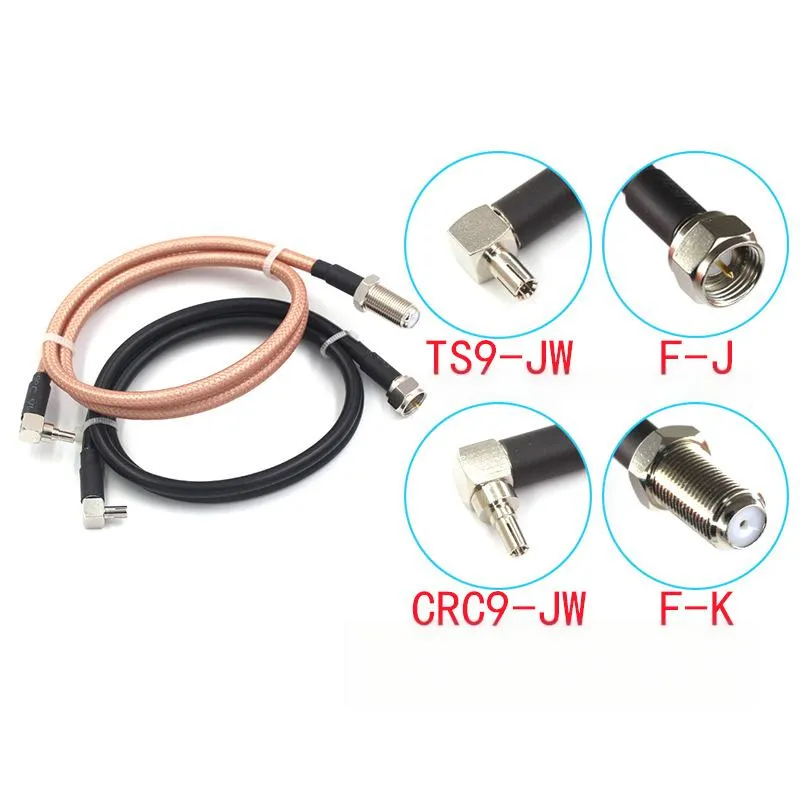
F-type connectors are the norm for RG6, ensuring stable HDTV, satellite, and broadband signals.
When it comes to TV and broadband, RG6 coaxial cable connectors almost always mean F-type connectors. They’re cheap, easy to crimp, and perfect for high-frequency signals in satellite, HDTV, and cable internet systems.
- A standard RG 6 connector (F-type) is what you’ll find on most set-top boxes, modems, and wall plates.
- In CCTV systems, RG59 is often paired with BNC connectors for quick-lock security camera connections.
- Need to hook into older AV gear? Both RG6 and RG59 can adapt to RCA connectors, though it’s less common today.
Tip: If you’re installing outdoor runs of RG6, look for compression-type RG6 connectors—they seal better against moisture than twist-on styles.
RG58 and Other 50Ω General-Purpose Cables
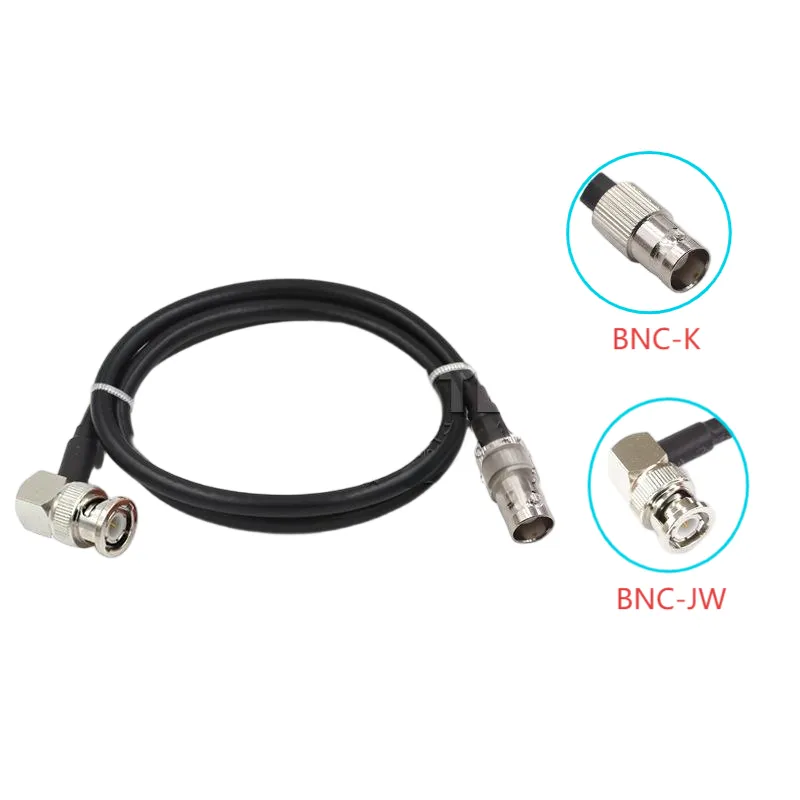
BNC connectors are quick-lock, making them ideal for CCTV cameras and lab testing with RG58.
The RG58 coaxial cable is versatile, so it sees a mix of connectors:
- BNC connectors are the classic lab and networking choice—easy bayonet lock, fast connect/disconnect.
- SMA connectors pair well when RG58 is used in Wi-Fi, GPS, or RF modules.
- N-type connectors come into play when RG213 coaxial cable or similar heavy-duty 50Ω lines are used outdoors, thanks to their weather resistance and power handling.
Quick rule: RG58 = BNC in the lab, SMA for modules, N-type for outdoor gear.
High-Performance Lines (RG142, RG316, RG402, RG405)
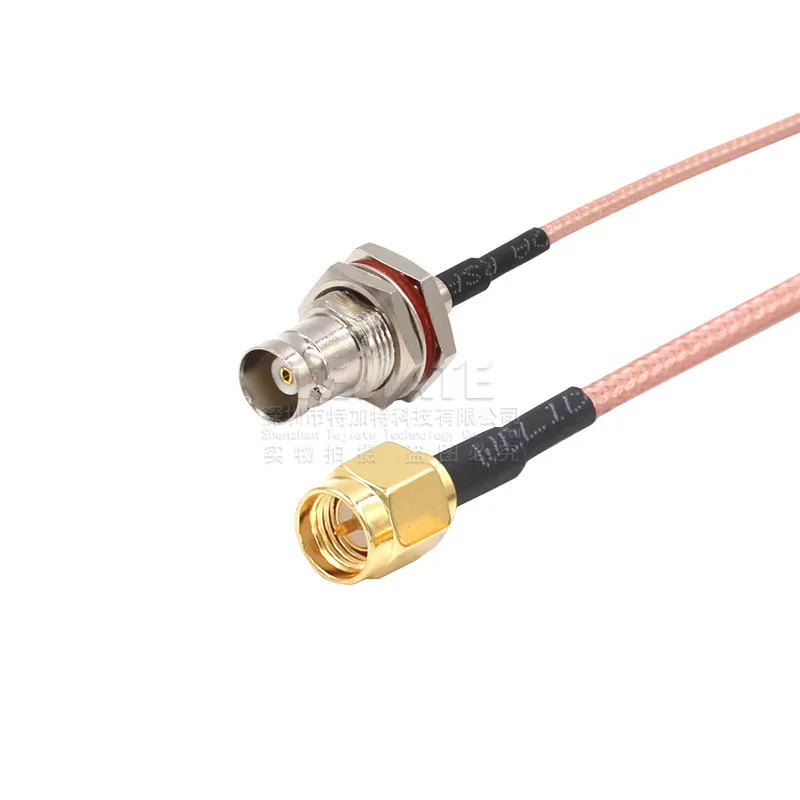
SMA connectors provide strong high-frequency performance for GPS modules, Wi-Fi cards, and RF adapters.
For cables used in microwave, aerospace, and defense, connector choice matters even more.
- RG142 and RG402 often terminate in SMA or N-type connectors, where low VSWR and high-frequency performance are required.
- RG316 coaxial cable, being slim and flexible, is frequently found with SMA connectors for GPS, Wi-Fi, and test adapters.
- RG405, as a semi-rigid line, usually ends in SMA or 2.92 mm (K-type) connectors, ideal for precision measurements at microwave frequencies.
Here, the connector isn’t just about size—it’s about frequency stability and reliability under stress.
Miniature Cables (RG174, RG178, RF0.81/1.13/1.37)
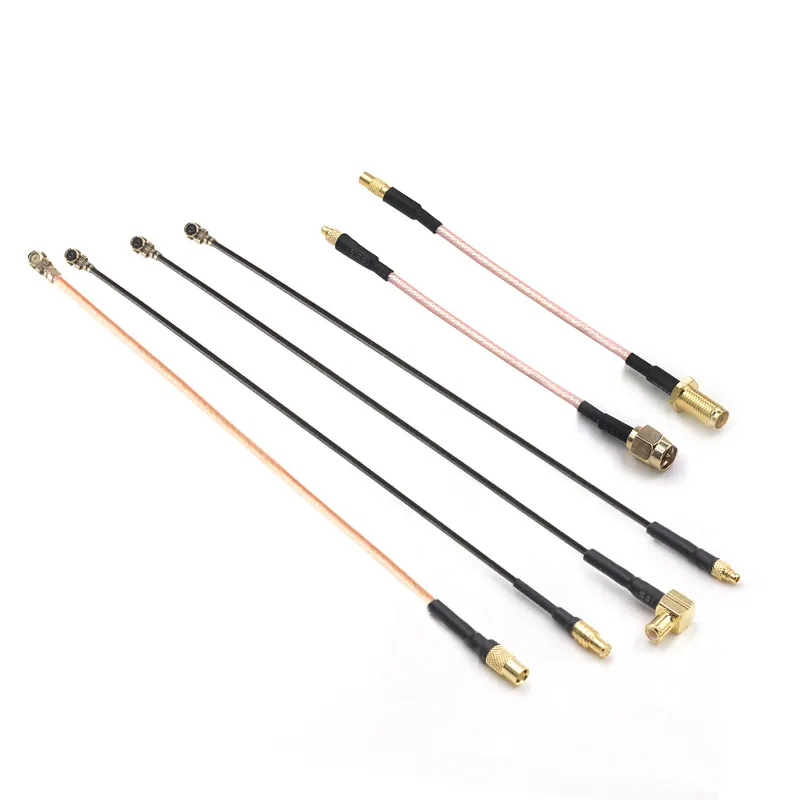
U.FL connectors enable compact RF designs in IoT devices, GPS receivers, and Wi-Fi cards.
Tiny cables call for tiny connectors.
- RG174 coaxial cable and RG178 are often terminated with SMA, MMCX, or SMB connectors, depending on the module.
- Ultra-thin cables like RF0.81, RF1.13, and RF1.37 nearly always use U.FL connectors, which you’ll see on GPS receivers, Wi-Fi cards, and IoT boards.
- In practice, these miniature jumpers are often paired with adapter cables that transition into larger connectors like SMA or N-type.
Example: A U.FL to SMA adapter cable lets a tiny IoT module with RF1.13 coax plug directly into an external SMA antenna.
Heavy-Duty Outdoor Cables (RG213, RG223)
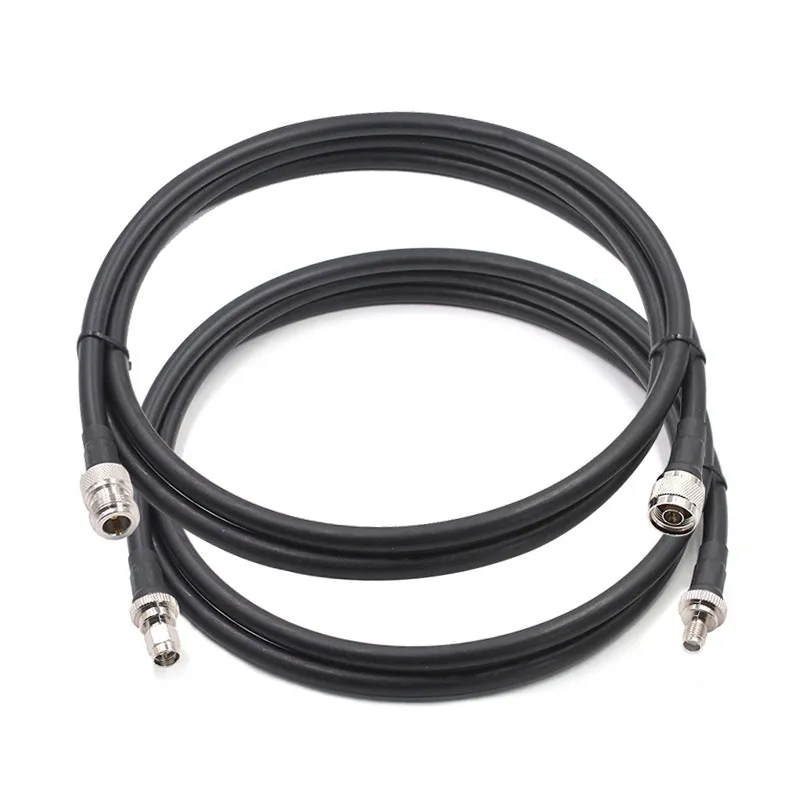
N-type connectors are weather-resistant, handling high power in outdoor and military RF systems
For field, ham, and military use, rugged connectors are a must.
- RG213 coaxial cable is usually paired with N-type or UHF (PL-259) connectors, both known for high power handling.
- RG223—thanks to its double shielding—also terminates in N-type connectors for stable, interference-free connections in aerospace and defense applications.
Pro tip: If you’re working in harsh environments, pre-terminated RF cable assemblies save you time and guarantee proper fit.
Applications of RG Cables
- Home TV & Broadband: RG6 is the modern standard, while RG59 lingers in older CCTV.
- Radio & Ham: RG58 for short flexible runs, RG213 for outdoor power and long distances.
- CCTV & Security: RG6 now dominates HD cameras; RG59 only for legacy systems.
- Laboratory & Aerospace: RG142, RG316, RG402, RG405 ensure low loss and stability in precision testing.
- IoT & Compact Devices: RG174, RG178, RG316 sneak into GPS, drones, and IoT boards where space is tight.
Bottom line: Match cable type to the environment and signal demands.
Technical Specs Table for RG Cables
Comparing different RG cable types on paper makes it much easier to see why one is chosen over another. Attenuation, impedance, and size all directly affect whether a cable belongs in a TV system, a ham radio shack, or a satellite test lab.
Here’s a consolidated table of the most widely used RG coaxial cables, including their impedance, size, loss figures, and common applications:
RG Cable Specifications
| Cable Model | Impedance (Ω) | OD (mm) | Attenuation @1 GHz (dB/100 m) | Conductor | Jacket | Temp. Range | Typical Applications |
|---|---|---|---|---|---|---|---|
| RF0.81 | 50 | 0.81 | ~310 | Silver-plated copper | FEP | — | High-frequency modules, mini RF jumpers |
| RF1.13 | 50 | 1.13 | ~232 | Tinned copper | FEP | — | GPS, Wi-Fi, IoT devices |
| RF1.37 | 50 | 1.37 | ~232 | Tinned copper | FEP | — | Embedded RF boards, IoT sensors |
| RG405 | 50 | 2.60 | ~72 | Silver-plated copper | Blue FEP | -65 °C to +150 °C | Aerospace, microwave, test systems |
| RG402 | 50 | 2.16 | ~70 | Silver-plated copper | PTFE/FEP | -55 °C to +200 °C | Semi-rigid microwave, aerospace labs |
| RG58 | 50 | 5.0 | ~766 | Bare copper | PVC | -20 °C to +70 °C | Radio, CCTV, networking test cables |
| RG59 | 75 | 6.1 | ~760 | Bare copper | PVC | -20 °C to +80 °C | TV, analog video |
| RG6 | 75 | 6.9 | ~600 | Bare copper | PVC/FPE | -40 °C to +75 °C | HDTV, satellite, broadband |
| RG213 | 50 | 10.3 | ~450 | Bare copper | PVC | -40 °C to +85 °C | Ham radio, military, outdoor RF |
| RG141 | 50 | 4.6 | ~41 | Silver-plated copper | Blue FEP | -55 °C to +150 °C | Radar, microwave, defense |
| RG174 | 50 | 2.85 | ~1100 | Bare copper | PVC | -20 °C to +70 °C | Flexible leads, mobile RF |
| RG178 | 50 | 1.80 | ~310 | Silver-plated copper | FEP (brown) | -55 °C to +200 °C | Aerospace, GPS, IoT |
| RG179 | 75 | 2.5 | ~760 (per 100 ft) | Silver-coated copper | FEP (brown) | -20 °C to +200 °C | Broadcast, instrumentation |
| RG316 | 50 | 2.5 | ~93 | Silver-plated copper | FEP (brown) | -55 °C to +200 °C | GPS, Wi-Fi, lab adapters |
| RG047 | 50 | 1.6 | ~100 | Silver-plated CCS | Blue FEP | up to 200 °C | Semi-flex precision RF |
| RG223 | 50 | 5.4 | ~1400 | Silver-coated copper | PVC | -20 °C to +80 °C | Military, EMI-sensitive systems |
How to Read This Table
- Impedance: 50Ω lines (RG58, RG213, RG142, RG316) serve RF communications, while 75Ω cables (RG6, RG59, RG179) dominate TV and video.
- Size vs Loss: Larger diameters like RG213 mean lower attenuation. Tiny lines like RF0.81 or RG178 are space savers but have higher loss.
- Temperature: High-performance cables such as RG142, RG402, RG405, RG178, and RG316 tolerate extreme conditions, making them aerospace-ready.
- Applications: Match your choice to the job—RG6 for home TV, RG58 for radios, RG213 for outdoor comms, RG316 for compact GPS/Wi-Fi gear.
If you don’t want to deal with crimping, TEJTE also provides ready-made RF cable assemblies that come pre-terminated for these common cable types.
Buying Guide: How to Choose the Right RG Cable
With dozens of RG cable types floating around, it’s easy to feel lost. The truth is, you don’t need to memorize every spec sheet—just narrow things down step by step. Here’s a simple checklist to help you match the right cable to the right job.
1. Check Impedance (50Ω vs 75Ω)
This is the first filter.
- 50Ω cables like RG58, RG213, RG142, and RG316 are built for RF communication, radios, and lab testing.
- 75Ω cables such as RG6, RG59, and RG179 dominate TV, satellite, and video transmission.
If you mismatch impedance—say, running a 75Ω RG6 coaxial cable in a 50Ω radio system—you’ll get reflections and signal loss. Always match impedance first.
2. Consider Frequency & Distance
How far is your signal going, and how high is the frequency?
- Short indoor runs: RG58 coaxial cable or RG59 can get the job done.
- Long outdoor runs: You’ll want a thicker low-loss cable like RG213 coaxial cable or RG6.
- High-frequency gear (microwave, radar): Step up to RG142, RG402, or RG405.
Rule of thumb: The longer the run and the higher the frequency, the bigger the cable you’ll need.
3. Balance Flexibility vs Durability
Not every installation is the same.
- Need something you can snake through racks or tight corners? Go with flexible cables like RG58 or RG316 coaxial cable.
- Installing in harsh outdoor conditions? Rugged lines like RG213 or semi-rigid types like RG405 are better suited.
- Working inside compact devices? Miniature cables such as RG174 coaxial cable or RG178 fit where bigger cables simply won’t.
4. Match the Connector
Even the best coax won’t work if the connector doesn’t fit.
- RG6 coaxial cable connectors (F-type) are the standard for TV and satellite.
- RG58 often pairs with BNC or SMA connectors.
- RG213 is commonly terminated with N-type or UHF connectors for outdoor and ham use.
- Miniature lines like RG174 or RG316 usually end in U.FL, MMCX, or SMA connectors.
Pro tip: Using high-quality RF adapter cables makes transitions between connector types painless.
5. Think About the Environment
Temperature and interference can make or break a system.
- High-temp environments (aerospace, defense): Look at RG142, RG316, or RG178—they handle heat up to 200℃.
- Noisy environments (factories, labs): Shielded cables like RG223 keep EMI out.
- Everyday home installs: RG6 for TV or broadband will cover most needs.
Final word: Choosing an RG cable isn’t about picking the most expensive option—it’s about matching impedance, distance, frequency, and connectors to your application. Get those four right, and your system will run smoothly for years.
FAQs About RG Cables
What does RG mean in cable?
Radio Guide, from U.S. military specs.
Which is better, RG11 or RG6?
RG11 has lower loss; RG6 is easier to install and standard for homes.
Which is better, RG8 or RG58?
RG8 is thicker and lower loss; RG58 is lighter and cheaper.
What is RG142 used for?
Aerospace, radar, microwave systems.
How thick is RG142 cable?
About 4.95 mm OD.
What is RG402?
A semi-rigid 50Ω coax for microwave/aerospace use.
What is RG405 spec?
50Ω, 2.6 mm OD, ~0.72 dB/m loss @ 1 GHz.
Which is better, RG58 or RG178?
RG178 for miniature IoT/aerospace, RG58 for labs/radios.
What is RG316 used for?
GPS, Wi-Fi, test equipment.
What is the frequency range of RG316?
Up to 3 GHz, some versions up to 6 GHz.
What is RG213 coax?
Rugged 50Ω outdoor/military cable.
Is RG213 the same as LMR400?
No—LMR400 has slightly lower loss, RG213 is tougher.
What type of connector is used with RG6 cable?
F-type (TV, broadband).
Is RG6 the same as RG58?
No—RG6 is 75Ω, RG58 is 50Ω.
Conclusion
The world of RG cables is a lot more diverse than it first appears. Behind the simple label “RG” is a whole family of coaxial designs—each with its own job to do.
For home users, the choice might be as simple as using an RG6 coaxial cable to keep your TV picture crisp and your broadband stable. In a workshop or test lab, a flexible RG58 coaxial cable or a slim RG316 coaxial cable is more likely to be on the bench. Out in the field, rugged lines such as RG213 coaxial cable are trusted for their durability and lower signal loss. And in aerospace or defense, high-frequency specialists like RG142, RG402, or RG405 make sure signals stay accurate even under extreme conditions.
The key takeaway? There’s no “one-size-fits-all” RG cable. The right pick depends on impedance, frequency, distance, and environment. Match those correctly, and your system will run reliably for years without unexpected dropouts or fuzzy signals.
And don’t forget the connectors. A well-chosen RG6 connector or an SMA adapter for RG316 can make the difference between a stable setup and hours of troubleshooting.
If your project calls for a mix—say bridging miniature RG174 or RG316 to larger cables like RG58 or RG213—pre-terminated assemblies can save time and reduce errors. TEJTE provides a full range of RF adapter cables and professional RF cable assemblies designed to cover everything from IoT devices to outdoor military-grade installations.
In short: pick the RG cable that matches your system, pair it with the right connector, and you’ll get stable, high-quality signal transmission—whether it’s for a TV in the living room or a radar test rig in the lab.
Bonfon Office Building, Longgang District, Shenzhen City, Guangdong Province, China

A China-based OEM/ODM RF communications supplier
Table of Contents
Owning your OEM/ODM/Private Label for Electronic Devices andComponents is now easier than ever.
